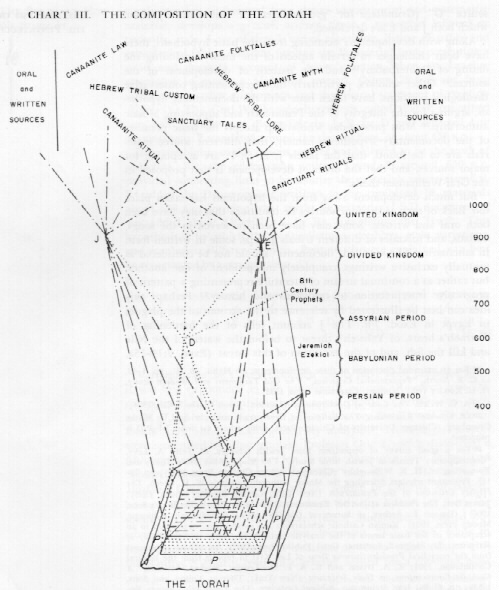
Ezra's
Torah?
Origens of the Old Testament Canon

Ezra's
Torah?
Origens of the Old Testament Canon
"The Nasarenes . . .They acknowledged Moses and believed that he had received laws - not this law, however, but some other. And so, they were Jews who kept all the Jewish observances, but they would not offer sacrifice or eat meat. They considered it unlawful to eat meat or make sacrifices with it. They claim that these Books (of Moses) are fictions, and that none of these customs were instituted by the fathers. (Panarion 1:18)
Many scholars have come to the conclusion that the present day Law of Moses could not have been written by Moses, but instead was probably written by Ezra. There is even an apocrypha account of Ezra's authorship in 4th Ezra.
The combining of the various sources was believed to be the work of redactors. Rje, the editor who united J and E around 650 B.C. provided connecting links to harmonize the materials where essential. Rd added the Deuteronomic writings to the combined JE materials about 550 B.C., forming what might be termed a J-E-D document. P was added about 450-400 B.C. by Rp, completing the Torah. This hypothesis,12 by which the contradictions, doublets, style variations, and vocabulary differences in the Pentateuch were explained, can best be represented by a straight line.

Variations in the Graf-Wellhausen theory have been proposed since it was first expounded in the nineteenth century. Research into the composition of the individual documents produced subdivisions such as J1, J2, J3, etc. for J, and El, E2, and so on, for E until the documents were almost disintegrated by analysis.13 New major sources were recognized by other scholars. Professor Otto Eissfeldt discovered a fifth source beginning with Gen. 2 and continuing into Judges and Samuel which he labeled "L" for "Lay" source.14 R. H. Pfeiffer of Harvard University identified an "S" source in Genesis, so labeled because Pfeiffer believed it came from Seir (in Edom) or from the south.15 The great Jewish scholar, Julian Morgenstern, singled out what he believed to be the oldest document, "K," which, while in fragmentary form, preserved a tradition of Moses' relationships with the Kenites.16 Martin Noth of Germany argued for a common basic source "G" (Grundlage for "ground-layer" or "foundation") upon which both J and E are developed.17
"Along with developments stemming from the basic hypothesis, there have been challenges to certain aspects of the theory, including the dating of Deuteronomy18 and the pattern of development of the sources.19 Other scholars, particularly those representing conservative theological positions, have taken issue with the documentary hypothesis, arguing for the integrity of the Pentateuch and supporting Mosaic authorship.20 Most present-day scholarship accepts the basic premises of the documentary hypothesis — namely, that different source materials are to be found, that the labels J, E, D, P, are acceptable for major sources, and that the order of development is that proposed in the Graf-Wellhausen thesis."(Old Testament Life and Literature by Gerald A. Larue)
"During the Persian period toward the close of the fifth and the beginning of the fourth centuries, the last major contribution was made to the Pentateuch. It has already been noted that the accumulation of priestly lore had been taking place in Babylon during the Exile. Now this process came to an end and the results were woven into the previously combined JE saga and into Deuteronomy. P
Within P there are clues that indicate that the final product was the result of editing and selection, perhaps done by one person. There are passages in disagreement, interruptions in continuity and isolated blocks of material.
Scholars usually place the time of the compilation of P in the post-Exilic period14 for a number of reasons. . . . The identity of the final editor or compiler is not known, but it can be assumed that he was a priest. Ezra has been put forth as a possible candidate, and it is suggested that P was the law that Ezra interpreted and imposed on the people. Unfortunately, these hypotheses cannot be confirmed. (Old Testament Life and Literature by Gerald A. Larue)
The Nazarenes of Mount Carmel
Copyright
© 1999-2006. All rights
reserved.
The Essene Numerology
Chart | Ministerial Training
Course